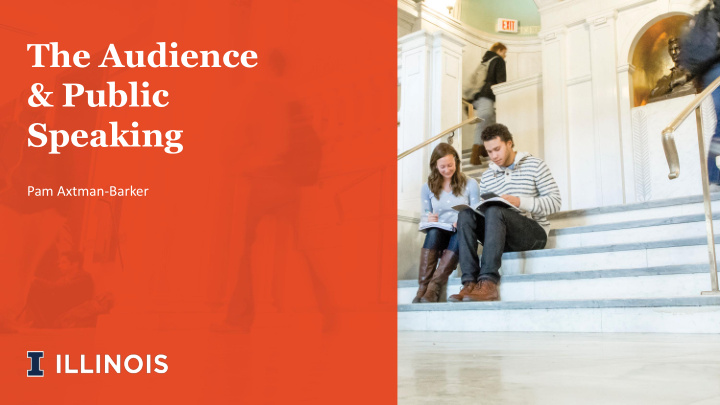



The Audience & Public Speaking Pam Axtman-Barker
Scenario A professor you had a year ago has reached out and asked you to come and speak to their current class for about 5 minutes. They request that you provide a students perspective on the class and tips for succeeding. What do you do to prepare for your talk?
Body text
Preview of Presentation 1. Model of Communication 2. Types of Audiences 3. Adapting to Audience 4. Application
Sender Receiver Model of Communication
Sender Receiver Model of Communication
Sender Receiver Model of Communication
Sender Receiver Model of Communication
Sender Receiver Model of Communication
Sender Receiver Model of Communication
Identifying Types of Audiences 1. Captive / Voluntary 2. Technical / Nontechnical 3. Profile
Captive / Voluntary • Captive Audiences: – Required to be there or there by incentive – Often less invested • Voluntary Audiences – Chose to attend – Typically more directly interested in topic
Captive Audiences Your Goal is to make them feel it was worth their time Be prepared and adapt for them • Clear, Concise message • Used time efficiently • Connected to their interests
Voluntary Audience This audience is likely already interested • They can opt out at any time – engagement is key
Technical/ Non-Technical • Technical Audiences: – Understand jargon – Familiar with methodology and content • Non-Technical Audiences – Not familiar with your topic/research – Varying levels of experience
Technical Audiences • Consider their level of technical knowledge • Consider what they care about / what matters to them – Do they want to see a bunch of math or do they want to see a finished prototype? Or something else – What are they expecting
Non-Technical Audiences • Create an opportunity for shared meaning – Identify a problem – Tell a story – Explain technical content • Remember, your audience can’t stop to look up a term they don’t understand, so think about what you might need to define for them
Create a Profile of the Audience • Demographics • Attitude toward the topic • Size of the audience • Setting of Speech
How can you learn these things about the audience? • In Advance… – Ask the coordinator – Conduct a survey (If appropriate) – Ask someone who has presented there before • In the Presentation – Look around
Sender Receiver Model of Communication
Non-verbal audience feedback Look at what your audience is doing when you are speaking • Engaged? • Tuned out? Adjust accordingly
Activity Talk to a partner about either: • Your weekend plans OR • What you did last weekend • A project you’ve been working on OR • A project you are thinking of starting
Strategies 1. Stories 2. Humor 3. Engagement 4. Organization
Stories Humans are storytellers • Use an example (real or imagined) • Start with a problem, end with a solution Your story should be: 1. Believable 2. Be logically consistent
Humor A well-placed, well-timed joke can help the audience engage HOWEVER, A bad, inappropriate, ill-timed joke can ruin the presentation
Engagement Audiences like direction • Show of hands • Thumb poll • Talk to a neighbor • Clicker Questions The key is participation!
Organization Preview • – “Today we will tell you about [A], then [B], then [C].” • Transitions – Review, Preview – “First we’d like to explain the objectives for our project” – “Now that I have discussed the design process, [Jeremy] is going to talk about areas for future research” Repetition • – “Again, our object was [X], so we focused on this element a lot.” – “In order to achieve [previously stated objective], we also focused on this” – “So as you can see, our results showed [restate results]” • Conclusion – “In conclusion, today we have presented our senior design project, explaining A, B, and C”
A couple of cautions 1. Don’t stereotype your audience 2. Do not simply tell the audience what they want to hear 3. Continue to analyze the audience as you are speaking
Will your audience be receptive to your message?
Is this message the right one for this audience?
Data is important. But data needs to be communicated in a way that can be understood.
Good Communication Matters The Visual Display of Quantitative Information Edward R Tufte 2001 Graphics Press
• The typography was sloppy. • Unnecessary icons of rockets obscured key numbers. • Worst of all, the performance data of the O-rings was arranged by launch date, rather than by the critical factor, temperature. That made it all but impossible for decision makers to envision that a launch in weather below 66 degrees probably would involve O-ring failure.
Sender Receiver Model of Communication
Good Communication starts with understanding your audience.
Contact us! speak.engineering.illinois.edu Pam Axtman-Barker Lead Program Administrator pamelaa2@Illinois.edu
Recommend
More recommend